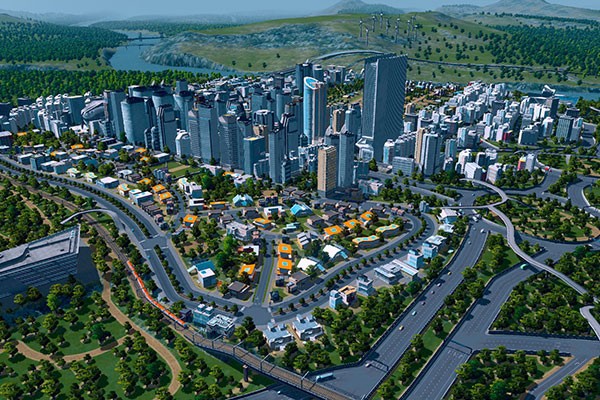Rating: 5/5
Do you remember Sim City? What used to be the great in-depth city builder was reduced to a disappointing, digital-rights-management-infested mess last year with the release of the series’ reboot. Long-time fans of the series were left behind as the late Maxis, which was shut down earlier this year, adopted what felt like a lacklustre forced social experience and sacrificed a lot in terms of the core mechanics that made Sim City so great. So why am I starting a review of Cities: Skylines with a summary of Sim City? Well, because in all practical senses, Cities: Skylines is Sim City or, more accurately, what it should have been.
In Skylines you are essentially a city planner, deciding where roads, zoning and important resources should go to keep your “Cims” happy. A zone must be designated on roadside, which can be easily done through the different tools at your disposal. As is typical of city builders, you have to manage the demand for residential, industrial and commercial spaces, with your Cims taking up residence, working and shopping in those areas. You also need to provide basic services, such as power, water and access to health, police and fire stations, as well as enough education opportunities for all ages.
Once you get this down, your people will be happy, notifying you through a Twitter-like feed. Cims like expressing their opinion quite a bit and you end up with a lot of repeated phrases. You can enforce policies in different areas of the map, including water and power regulation, tax breaks or raises, and even a “recreational use” clause.
The interface of Skylines is quite intuitive, with many tools provided to help you to build your city. You can also check different aspects, such as pollution, education and happiness, through a set of tools that display a visual colour gradient. The many aspects you have to manage can border on overwhelming, but it is gratifying to get it right.
However, one aspect is more important than all the others — your traffic. As your city grows, you will have more Cims trying to get places. Expanding your city also unlocks new buildings at different milestones, as well as services to help you manage your city. However, if you fail to build your streets in a way that allows your Cims to travel to and from their home and work, as well as providing routes for the large number of industry trucks arriving from outside your borders, you will end up with buildings being abandoned and your traffic congested, with no one able to move anywhere in a reasonable amount of time. This will grind your services to a halt (for example, if garbage collectors cannot get to houses, rubbish will pile up inside) and your Cims will complain. You can use public transport to reduce the pressure, but it will only get you so far. Roads will become your best friend. Once you build a working road system, it makes the game immensely satisfying.
The game looks great, plays great and is a solid city builder, probably the best at this time. Even though there are a few issues, such as the space you can build in being limited to only nine selectable squares and having to manually demolish each abandoned building, it easily makes up for any flaws with its last feature: its connection with steam. Skylines has full steam workshop support, including game-altering mods that let you fix these problems easily. There are also handy tools to find out why your traffic is being congested, and pre-made intersections to help you build. This feature pushes Skylines into “must have” territory if you are a fan of this style of gaming. Just be prepared for it to soak up many hours of your life.



